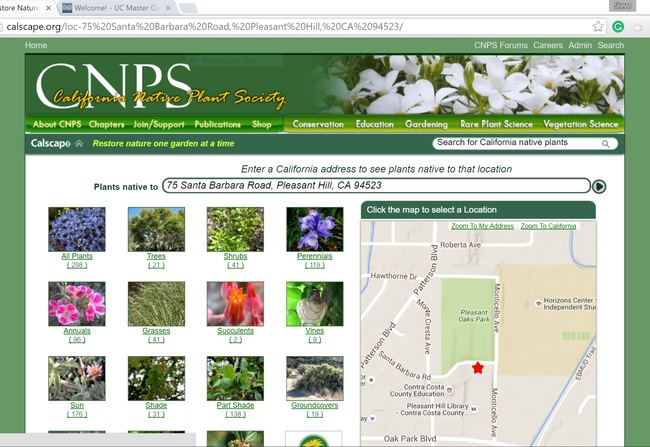Advice From the Help Desk
of the UC Master Gardener Program
Less than 2 weeks ago, the “‘Bringing Back the Natives” sponsored and showcased an extensive tour of home gardens that utilize primarily California native plants. The tour highlighted what you can do in your garden using native plants as well as minimizing your water use and providing habitat for native wildlife.
While the plants featured were California native plants, they may not be "native" to where the garden was actually located. Have you ever wondered what the “native plants” were where you actually live and garden? Well, the California Native Plant Society along with UC's Jepson Herbarium (and many other herbariums and collectors) did and they have implemented a very useful graphic database on the web, www.calscape.org, that has cataloged what actually was native to your garden … right down to your address. So now you can "easily" plant and grow what was originally “native” vs. what “natives” you could grow… maybe. Their efforts are at www.calscape.org.
Below are edited excerpts from the “About” page of calscape.org to entice you to check it out:
“About Calscape
Our goal at Calscape is to help Californians restore nature and save water one garden at a time. We do this by showing people which plants are really native to any location in the state, helping them figure out which ones they want, and where to buy them and how to grow them.
California is an extremely environmentally diverse state. Different California native plants evolved to grow in areas of the state with very different temperatures, rainfall levels, summer drought periods, air moisture levels, and marine influences, among other factors. Because of this, it's always best to grow California native plants in the areas in which they evolved. They are easier to grow, healthier and require little or no artificial irrigation when they are planted in an area in which they evolved and naturally belong. Native California plants that aren't really native to that location will often struggle or die no matter how much you water them.
True native plants are the foundation for nature restoration. They attract birds, reptiles, amphibians, small mammals and insects and other pollinators that evolved with those plants, and over time create a working natural ecosystem, without pesticides, and without artificial fertilizers. The bird life in particular in a true natural garden is often spectacular. With the right plants, it's not hard for homeowners to create small patches of nature throughout even the developed part of the state.
Our estimates for which plant species naturally grow in each square mile of California are based on algorithms using the GPS locations of over a million field occurrences of native California plant species provided by the participants of the California Consortia of Herbaria, the 36Jepson geographic subdivisions, and detailed elevations profiles within each square mile of California.
Sources of plant photos include Calphotos, and dozens of amazing plant photographers who have agreed to share their photos with Calscape. Authorship and copyright information is shown under each plant photo.
Other sources include Wikipedia, which is an important source for the "About" sections in the Calscape plant pages. In many cases the sections have been edited and built on by Calscape volunteer editors. …
[S]unset information was provided by The Jepson Flora Project.
Propagation from seed information was provided by the Santa Barbara Botanical Garden from "Seed Propagation of Native California Plants" by Dara E. Emery.
Other general sources of information include Calflora, CNPS Manual of Vegetation Online, Jepson eFlora, Las Pilitas, Theodore Payne, Tree of Life, The Xerces Society, and information provided by CNPS volunteer editors, with special thanks to Don Rideout.”
The input and effort for Calscape.org is very impressive, solid, and can only get better as it allows for edited input on locations, plants, etc. (e.g., think Wikipedia) If you are interested in the impetus that led to calscape.org and how it was “built”, you may also be interested in a recent radio interview with one of calscape.org's leaders, Dan Mudd. The interview can be found on the Farmer Fred's KFBK radio show podcast of April 24 @ http://www.iheart.com/show/The-KFBK-Garden-Show/?episode_id=27502621, specifically starting at about the 19:35 minutes mark into the podcast to about 29:50 minutes.
Help Desk of the UC Master Gardener Program of Contra Costa (SIM)
Note: The UC Master Gardeners Program of Contra Costa's Help Desk is available year-round to answer your gardening questions. Except for a few holidays, we're open every week, Monday through Thursday for walk-ins from 9:00 am to Noon at 75 Santa Barbara Road, 2d Floor, Pleasant Hill, CA 94523. We can also be reached via telephone: (925) 646-6586, email: ccmg@ucanr.edu, or on the web at http://ccmg.ucanr.edu/Ask_Us/ MGCC Blogs can be found at http://ccmg.ucanr.edu/HortCoCo/ You can also subscribe to the Blog (//ucanr.edu/blogs/CCMGBlog/).
